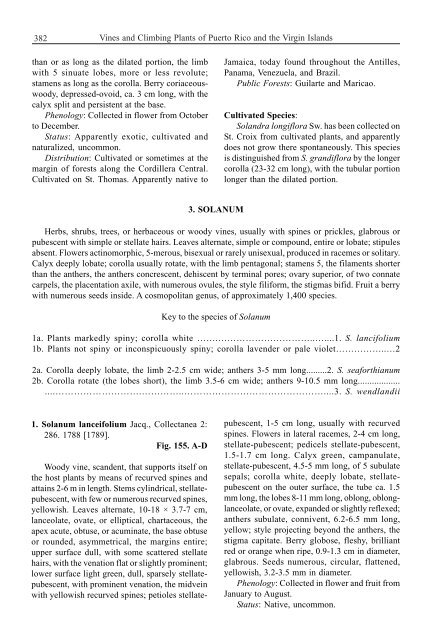Vines and Climbing Plants of Puerto Rico and the Virgin Islands
Vines and Climbing Plants of Puerto Rico and the Virgin Islands
Vines and Climbing Plants of Puerto Rico and the Virgin Islands
Create successful ePaper yourself
Turn your PDF publications into a flip-book with our unique Google optimized e-Paper software.
382<br />
<strong>Vines</strong> <strong>and</strong> <strong>Climbing</strong> <strong>Plants</strong> <strong>of</strong> <strong>Puerto</strong> <strong>Rico</strong> <strong>and</strong> <strong>the</strong> <strong>Virgin</strong> Isl<strong>and</strong>s<br />
than or as long as <strong>the</strong> dilated portion, <strong>the</strong> limb<br />
with 5 sinuate lobes, more or less revolute;<br />
stamens as long as <strong>the</strong> corolla. Berry coriaceouswoody,<br />
depressed-ovoid, ca. 3 cm long, with <strong>the</strong><br />
calyx split <strong>and</strong> persistent at <strong>the</strong> base.<br />
Phenology: Collected in flower from October<br />
to December.<br />
Status: Apparently exotic, cultivated <strong>and</strong><br />
naturalized, uncommon.<br />
Distribution: Cultivated or sometimes at <strong>the</strong><br />
margin <strong>of</strong> forests along <strong>the</strong> Cordillera Central.<br />
Cultivated on St. Thomas. Apparently native to<br />
1. Solanum lanceifolium Jacq., Collectanea 2:<br />
286. 1788 [1789].<br />
Fig. 155. A-D<br />
Woody vine, sc<strong>and</strong>ent, that supports itself on<br />
<strong>the</strong> host plants by means <strong>of</strong> recurved spines <strong>and</strong><br />
attains 2-6 m in length. Stems cylindrical, stellatepubescent,<br />
with few or numerous recurved spines,<br />
yellowish. Leaves alternate, 10-18 × 3.7-7 cm,<br />
lanceolate, ovate, or elliptical, chartaceous, <strong>the</strong><br />
apex acute, obtuse, or acuminate, <strong>the</strong> base obtuse<br />
or rounded, asymmetrical, <strong>the</strong> margins entire;<br />
upper surface dull, with some scattered stellate<br />
hairs, with <strong>the</strong> venation flat or slightly prominent;<br />
lower surface light green, dull, sparsely stellatepubescent,<br />
with prominent venation, <strong>the</strong> midvein<br />
with yellowish recurved spines; petioles stellate-<br />
3. SOLANUM<br />
Jamaica, today found throughout <strong>the</strong> Antilles,<br />
Panama, Venezuela, <strong>and</strong> Brazil.<br />
Public Forests: Guilarte <strong>and</strong> Maricao.<br />
Cultivated Species:<br />
Sol<strong>and</strong>ra longiflora Sw. has been collected on<br />
St. Croix from cultivated plants, <strong>and</strong> apparently<br />
does not grow <strong>the</strong>re spontaneously. This species<br />
is distinguished from S. gr<strong>and</strong>iflora by <strong>the</strong> longer<br />
corolla (23-32 cm long), with <strong>the</strong> tubular portion<br />
longer than <strong>the</strong> dilated portion.<br />
Herbs, shrubs, trees, or herbaceous or woody vines, usually with spines or prickles, glabrous or<br />
pubescent with simple or stellate hairs. Leaves alternate, simple or compound, entire or lobate; stipules<br />
absent. Flowers actinomorphic, 5-merous, bisexual or rarely unisexual, produced in racemes or solitary.<br />
Calyx deeply lobate; corolla usually rotate, with <strong>the</strong> limb pentagonal; stamens 5, <strong>the</strong> filaments shorter<br />
than <strong>the</strong> an<strong>the</strong>rs, <strong>the</strong> an<strong>the</strong>rs concrescent, dehiscent by terminal pores; ovary superior, <strong>of</strong> two connate<br />
carpels, <strong>the</strong> placentation axile, with numerous ovules, <strong>the</strong> style filiform, <strong>the</strong> stigmas bifid. Fruit a berry<br />
with numerous seeds inside. A cosmopolitan genus, <strong>of</strong> approximately 1,400 species.<br />
Key to <strong>the</strong> species <strong>of</strong> Solanum<br />
1a. <strong>Plants</strong> markedly spiny; corolla white …….…………………………..…....1. S. lancifolium<br />
1b. <strong>Plants</strong> not spiny or inconspicuously spiny; corolla lavender or pale violet……………..…2<br />
2a. Corolla deeply lobate, <strong>the</strong> limb 2-2.5 cm wide; an<strong>the</strong>rs 3-5 mm long.........2. S. seaforthianum<br />
2b. Corolla rotate (<strong>the</strong> lobes short), <strong>the</strong> limb 3.5-6 cm wide; an<strong>the</strong>rs 9-10.5 mm long..................<br />
....……………………….…………..………………………………………....3. S. wendl<strong>and</strong>ii<br />
pubescent, 1-5 cm long, usually with recurved<br />
spines. Flowers in lateral racemes, 2-4 cm long,<br />
stellate-pubescent; pedicels stellate-pubescent,<br />
1.5-1.7 cm long. Calyx green, campanulate,<br />
stellate-pubescent, 4.5-5 mm long, <strong>of</strong> 5 subulate<br />
sepals; corolla white, deeply lobate, stellatepubescent<br />
on <strong>the</strong> outer surface, <strong>the</strong> tube ca. 1.5<br />
mm long, <strong>the</strong> lobes 8-11 mm long, oblong, oblonglanceolate,<br />
or ovate, exp<strong>and</strong>ed or slightly reflexed;<br />
an<strong>the</strong>rs subulate, connivent, 6.2-6.5 mm long,<br />
yellow; style projecting beyond <strong>the</strong> an<strong>the</strong>rs, <strong>the</strong><br />
stigma capitate. Berry globose, fleshy, brilliant<br />
red or orange when ripe, 0.9-1.3 cm in diameter,<br />
glabrous. Seeds numerous, circular, flattened,<br />
yellowish, 3.2-3.5 mm in diameter.<br />
Phenology: Collected in flower <strong>and</strong> fruit from<br />
January to August.<br />
Status: Native, uncommon.
















